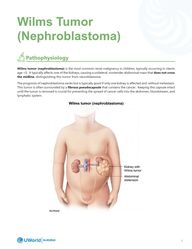
Return to flip book view
Message Wilms Tumor (Nephroblastoma)1PathophysiologyWilms tumor (nephroblastoma) is the most common renal malignancy in children, typically occurring in clients age <5. It typically affects one of the kidneys, causing a unilateral, nontender abdominal mass that does not cross the midline, distinguishing this tumor from neuroblastoma. The prognosis of nephroblastoma varies but is typically good if only one kidney is affected and without metastasis. This tumor is often surrounded by a fibrous pseudocapsule that contains the cancer. Keeping this capsule intact until the tumor is removed is crucial for preventing the spread of cancer cells into the abdomen, bloodstream, and lymphatic system.
Wilms Tumor (Nephroblastoma)2Risk FactorsThe occurrence of nephroblastoma may be related to a genetic inheritance and is thought to be associated with several congenital anomalies, including:WAGR syndrome Beckwith-Wiedemann syndrome y Group of chromosomal and genetic mutations y If the client is noted to have one, other family members should be screened and monitored for: ○ Wilms tumor ○ Aniridia (partial or complete absence of iris) ○ Genitourinary malformations ○ Range of mental disabilities y Hemihypertrophy (one side of the body is larger than the other) y Macroglossia (tongue disproportionately larger than rest of mouth) y Omphalocele (abdominal organs protruding from the body at birth) y Visceromegaly (enlarged abdominal organs)ManifestationsAn unusual contour with a palpable, unilateral, firm mass in the client's abdomen is suggestive of nephroblastoma, and diagnosis is confirmed by radiologic imaging (eg, ultrasonography, CT scan, MRI).Additional clinical manifestations of Wilms tumor include:Hematuria and anemia y Related to bleeding within the renal tumor y Blood loss → anemia → pallor and lethargySystemic features y Weight/appetite loss (anorexia), appetite suppression, feverElevated blood pressure y Due to increased renin secretion from the tumorAnorexia and weight loss y Often secondary to an increased production of proinflammatory mediators and nutrients being redirected to the tumorAbdominal pain y Present in less than half of clientsClients may also have congenital urological anomalies, including: ● Cryptorchidism (undescended testicle) ● Hypospadias (translocation of the urethra to the penile shaft)
Wilms Tumor (Nephroblastoma)3Wilms Tumor StagingStage I ● One kidney is involved, and the tumor can be completely excised. There is no regional lymph node involvementStage II ● Malignancy has spread to involve surrounding tissue but can be excised. There is no regional lymph node involvementStage III ● Residual surrounding cancer after surgical excision. There is metastasis to regional lymph nodes (within pelvis/abdomen)Stage IV ● There is distant metastasis to the lung, liver, brain, or boneStage V ● Both kidneys are involved at the time of initial diagnosisInterventionsSurgical removal of the affected tumor and kidney (nephrectomy) is the treatment of choice for Wilms tumor, but treatment may also involve chemotherapy and/or radiation.Additional interventions include: ● Avoid palpating the abdomen during assessments ○ Palpation or manipulation of the encapsulated tumor may result in rupture of the tumor, causing the cancer cells to spread (metastasize) into the abdomen ○ Therefore, the nurse should not palpate the abdomen and should post a "DO NOT PALPATE ABDOMEN" sign at the bedside Palpating the abdomen of a client who has Wilms tumor can disseminate cancer cells into surrounding tissues and should be avoided. ● Limit activity prior to surgical removal of the tumor ○ Prior to surgery, the client's activity should be limited to reduce disruption of the encapsulated tumor and the client should be handled carefully during bathing ● Regularly measure abdominal circumference ○ To monitor for increasing swelling ● Monitor for hypertension ○ Some clients may have hypertension due to excess production of renin ○ Administer antihypertensives as needed ● Monitor kidney function ○ Clients are at risk for renal failure ● Monitor client after abdominal surgery ○ Assess for the return of bowel sounds ○ Report abdominal distension, vomiting, signs of infection (eg, fever) or bowel obstruction (eg, ileus) to the health care provider ○ Strict intake and output; obtain daily weights ○ Monitor and control pain ○ Advance diet as prescribed and tolerated ● Assist with coping during hospitalization ○ Provide age-appropriate teaching of diagnosis (eg, drawing pictures of the kidneys, using a doll for surgery demonstration) ○ Encourage use of a comfort item brought from home (eg, plush toy, blanket)
Wilms Tumor (Nephroblastoma)4Check for Understanding 1The nurse is planning care for a client with Wilms tumor (nephroblastoma) who is scheduled for a nephrectomy. Which of the following interventions should the nurse include in the client’s plan of care? Select all that apply.a) Monitor for hypertension.b) Measure the abdominal girth. c) Apply a heating pad to the abdomen. d) Check the serum glucose level every hour.e) Encourage participation in physical activity with other clients.Check for Understanding 2The nurse is assessing a client with Wilms tumor (nephroblastoma). Which of the following findings would be consistent with the condition? Select all that apply.a) hematuria b) increased appetitec) abdominal distensiond) decreased appetite and weight losse) palpable mass that crosses abdominal midlineCheck for Understanding 3The nurse is teaching the parents of a child with Wilms tumor (nephroblastoma). Which of the following statements should the nurse include?a) "The tumor is surrounded by a fibrous pseudocapsule."b) "This tumor is benign and is removed only if it causes significant discomfort."c) "The tumor involves the nerve cells and typically occurs in the adrenal glands."d) "This tumor was likely caused by maternal consumption of alcohol during early fetal development."Answers1) a,b2) a,c,d3) a